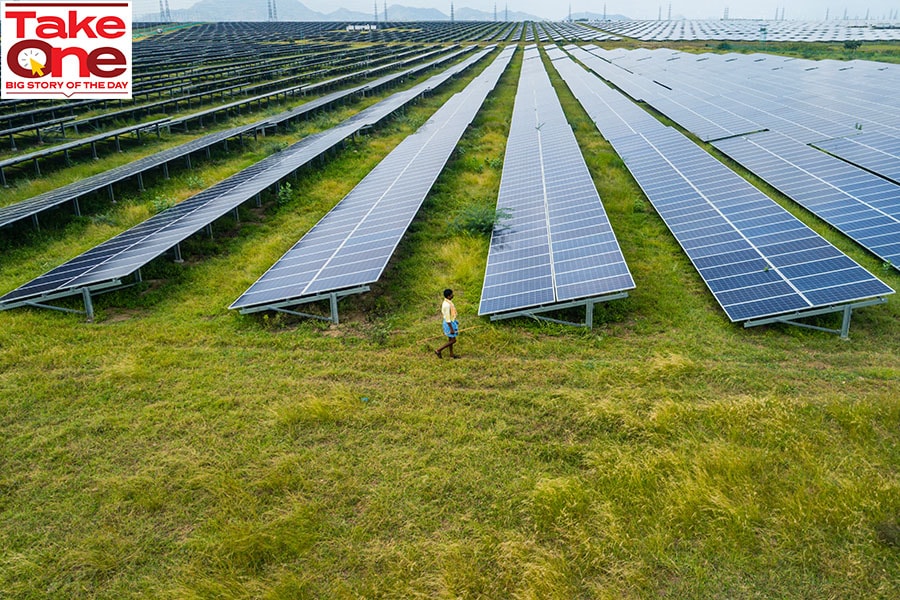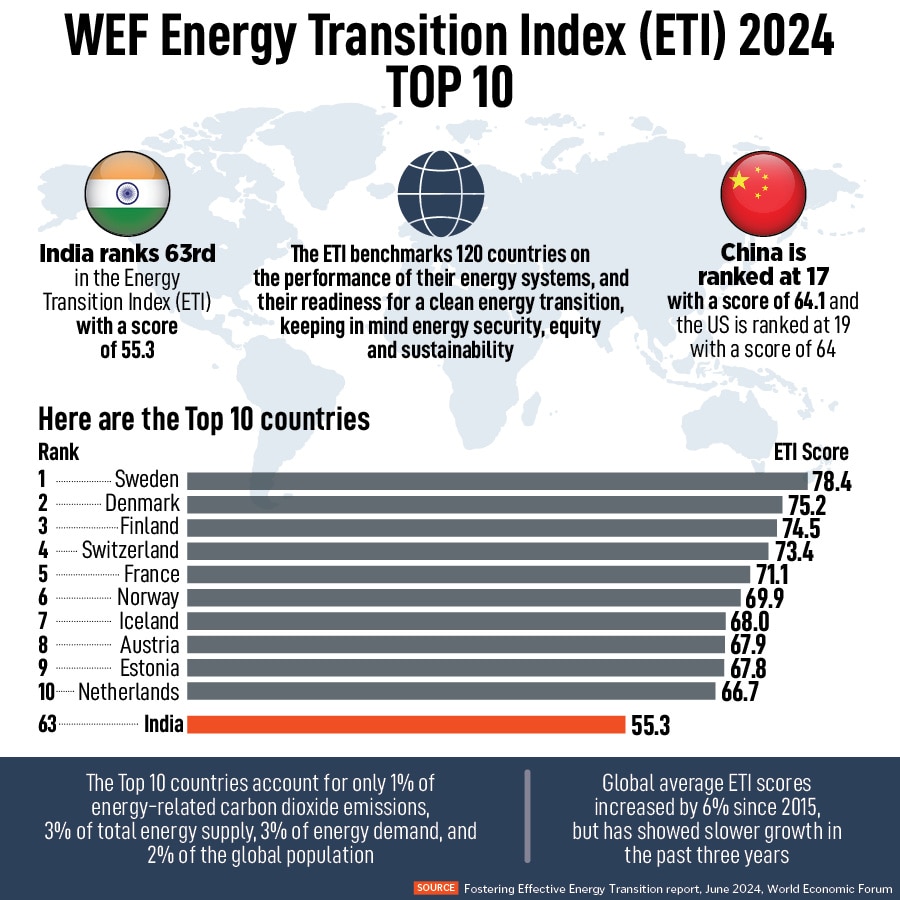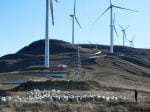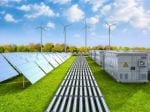There is opportunity to create more jobs in the green energy economy: World Economic Forum's Espen Mehlum
Speaking about the WEF's recently released report Fostering Effective Energy Transition, Mehlum discusses the progress India has made in clean energy transition, and what more needs to be done
 India, which ranks 63rd in the World Economic Forum's Energy Transition Index, wants to achieve 500GW of non-fossil fuel capacity by 2030, which means adding at least 50GW capacity every year.
Image: Abhishek Chinnappa/Getty Images
India, which ranks 63rd in the World Economic Forum's Energy Transition Index, wants to achieve 500GW of non-fossil fuel capacity by 2030, which means adding at least 50GW capacity every year.
Image: Abhishek Chinnappa/Getty Images
The World Economic Forum (WEF) recently released a report called Fostering Effective Energy Transition 2024, and the latest edition of the Energy Transition Index (ETI), which benchmarks 120 countries on the performance of their energy systems, in view of energy security, equity and sustainability.
India ranks 63rd on the index, up from rank 67 a year ago. On top is Sweden, followed by Denmark, Finland, Switzerland and France. China is ranked at number 17.
Transition readiness of countries has progressed, driven by regulations, political commitment, education, human capital and infrastructure. “While innovation growth has slowed, countries like India and China are leading in developing new energy solutions and technology, states the report, which was released on June 19.
Espen Mehlum, head, energy transition intelligence and regional acceleration, Centre of Energy and Materials at the World Economic Forum, speaks to Forbes India about the factors that set India apart from other countries as far as clean energy transition is concerned, why it’s important to decouple GDP growth with energy demand, and the potential for green tech manufacturing and artificial intelligence (AI) in clean energy. Edited excerpts:
 Espen Mehlum, Head, energy transition intelligence and regional acceleration, Centre of Energy and Materials at the World Economic Forum
Espen Mehlum, Head, energy transition intelligence and regional acceleration, Centre of Energy and Materials at the World Economic ForumQ. India ranks 63rd out of 120 countries in the energy transition index. It was 67th last year. What kind of progress has India made in transitioning to clean energy over the past two years?
The Fostering Effective Energy Transition report is in its 14th year, and it benchmarks energy systems of 120 countries in a holistic way, of not only [energy] sustainability, but also equity, security and readiness for transition on 46 indicators. India is one of those countries that has made a lot of progress over those years. It was 67 last year, and 63 this year, but the trend is positive.
Some of the efforts that the country is doing will only show on the index in subsequent years. I have highlight a few: What’s been achieved on the universal access to electricity and the remarkable progress on access to clean cooking through the LPG network and direct support to households. It’s very impressive also by international standards. Also leveraging some of these opportunities to create income for households and small businesses.
India has been quite successful, for instance, with the rooftop solar programme. Some of the more macro targets, like committing to net-zero by 2070, and coupling that very concrete targets, like 500GW of renewables capacity by 2030. The annual targets have been set for tendering 50GW a year to get there. That’s been among the success factors for India so far.
Q. The transition readiness score of India, which is the extent to which an enabling environment can be created for energy transition, is at 42.8. Is that a low score or a cause for concern?
The enabling environment [score] is looking into different factors such as skills, the policy environment, availability of capital, innovation, technology etc. In comparison to the advanced economies, there is room for improvement, but compared to where India was coming from, and some of the emerging and developing economies, this is a fairly good score.
The education system in India is supporting the potential growth as well of jobs in this area. We have seen from our data that there is more opportunity to create more jobs in the green energy economy, manufacturing etc. So that’s something to look into for the country. Obviously, attracting capital, not just domestically, but also internationally, is important. And the cost of capital available plays a role there. But, in all, there’s a steadily improving enabling environment to support the transition in India, both centrally, but also at the state level, because a lot of progress needs to happen at the state level as well.
Q. Moody’s Ratings recently estimated India would need around $190 billion to $215 billion to build the 500 GW non-fossil fuel capacity by 2030. Will that be a challenge for India?
India has a strong economy and a fairly deep capital base. A lot can be done to also tap into the domestic capital base and using things like the bond market. We see that $1.2 trillion were invested last year in clean energy worldwide, but only 16 percent of that is going to emerging and developing economies. If you take China out of the equation, because China is the biggest investor, among the emerging, developing economies, together with Brazil, India is also very successful.
There are two challenges for attracting more international capital: One, the cost of capital, and [two] the currency exchange risk that adds to the cost of capital. It’s not only for India, but also for other economies. And what will drive opportunities are the policies that are put in place so that it is attractive for companies to invest.
Also read: Clean Power: At 7 GW, India installs highest renewable energy sources in March
Q. What would it take to decouple energy demand and GDP growth? In India, for example, even though we have made progress in building non-fossil fuel capacity, the dependence on coal and thermal remains.
The world needs a double decoupling. The first decoupling is energy consumption from economic growth. The second is energy consumption from emissions. All countries will have different challenges coming from different starting points, but at a macro level, that really needs to happen.
Right now, India has a fairly low energy consumption per capita, which, at 1.7 tonnes of carbon dioxide per capita, is 60 percent lower than the global average. There is, of course, the need to power the growth of the country, for which more energy will be needed. That’s why coal capacity is relied upon to deliver the affordable energy that the country needs. At the same time, the country is also gearing up on renewables, biofuels, green hydrogen, electric mobility. It’s important for India to keep in mind that it is important to be able to decouple future growth from energy consumption, because that will also make the country more energy independent and not rely too much on energy imports.

Q. Are there factors that set India apart from other countries when it comes to its energy transition path?
Yes. There are similarities with other countries as well as far as the need to balance energy security, sustainability and equity is concerned. India is a huge, fast-growing economy. India and China are in a special position, with huge populations. A few things set India apart. One is the need to provide affordable access to everybody.
Progress has been made in giving electricity access to everybody and clean cooking. Second is the huge labour force, which are looking for opportunities in the economy. The energy sector could be among those that can provide those opportunities, if the right policies are in place, along with business investors etc. Third is the positioning of India in Asia. Asia is the fastest growing region worldwide, when it comes to economic growth, population growth and energy demand growth. A lot of countries are looking at India as a partner, be it on green hydrogen, or to learn from India’s experience on how to solve clean cooking or electrification challenge.
Q. The report says that while countries like India and China are making progress in clean energy, advanced economies like the US, Germany and Japan are showing a reversal in clean energy transition. Does this point to a long-term challenge in energy transition?
The countries you mentioned are big economies and they perform fairly well on the index. For instance, Germany is number 11, US is number 19, and Japan is somewhere in the 20s. These are advanced economies that have made a lot of progress in the past, but we have also seen a slowdown in their momentum, as you rightly point out. Part of that has been the impacts of the global energy crisis, geopolitical and economic volatilities, which have also impacted the cost of energy in these countries. For instance, Japan is importing a lot of natural gas, is very dependent on energy imports—the costs have gone up, and their renewables base is smaller. They do not have the same natural potential as some of the other countries. They are an island [country] so they have to import what they cannot produce themselves. Plus, there has been a question in Japan on the future of nuclear energy following the Fukushima accident.
In the US, we have seen the IRA [Inflation Reduction Act] package driving a lot of momentum and investments in recent years, and we’ve also seen that there have been complications with the global supply chains, costs of new equipment, and getting things to scale and connected to the grid rapidly. Germany, of course, had challenges with the dependence on Russian gas, and the need to rework that.
Q. The report says that India has a lot of potential for green tech manufacturing. Could you reflect more on that?
Green tech manufacturing, or manufacturing more widely, is a huge opportunity for many countries. There are a few factors that will matter in terms of determining that. One is the space to scale up in the country and the right education levels to deliver green tech manufacturing in those specific sectors. The second is the costs. How much does it cost to produce in India versus another country? Third is the technological edge. To what extent can advanced technologies be adopted in the manufacturing process. Fourth is the domestic market size. A huge domestic market in India, for example, plays in its favour. The last point is international competition, because there will be many countries that will want to build a green tech manufacturing base.
India is well-positioned in a few areas. For instance, electric mobility, especially two-wheelers and three-wheelers. But as you know, good adoption and the industry leading the way cannot lead to increase in manufacturing in that space. Of course, on batteries, it will be a huge market, but there’s a question as to whether some of the manufacturing can happen in India. There are also new areas such as artificial intelligence (AI), where India’s digital skills can play in its favour.
Q. How prominent or significant will artificial intelligence be in energy transition?
That’s yet to be seen, but the potential is huge. We [World Economic Forum] did a report on AI for energy transition three years ago, and was ahead of the curve. At that point, we hadn’t really started. Now, internationally, we see AI being deployed across the economy, not just in energy. Data centres are being built everywhere. These data centres use a lot of power. There is a question mark over can that power be clean, if it is available, does it compete with other uses of power, and how fast can we add that capacity.
There’s also the positive side, which is that AI can be a tool to make energy more efficient, more sustainable, and more secure, if used in the right way. But I think a lot more work is to be done on this topic to really understand what's going to be the energy footprint of AI. How can we optimise it? How can we really use it as a tool to do in the initial energy transition? That's something we are working on.


















